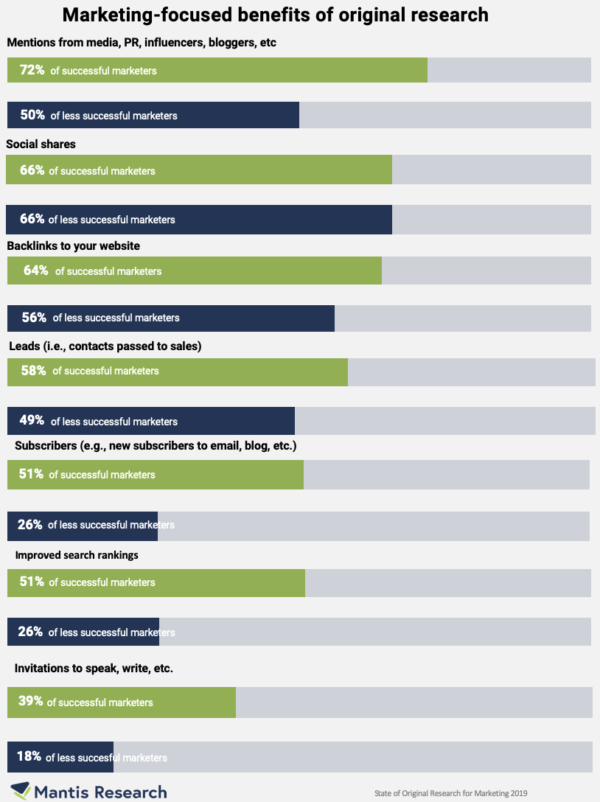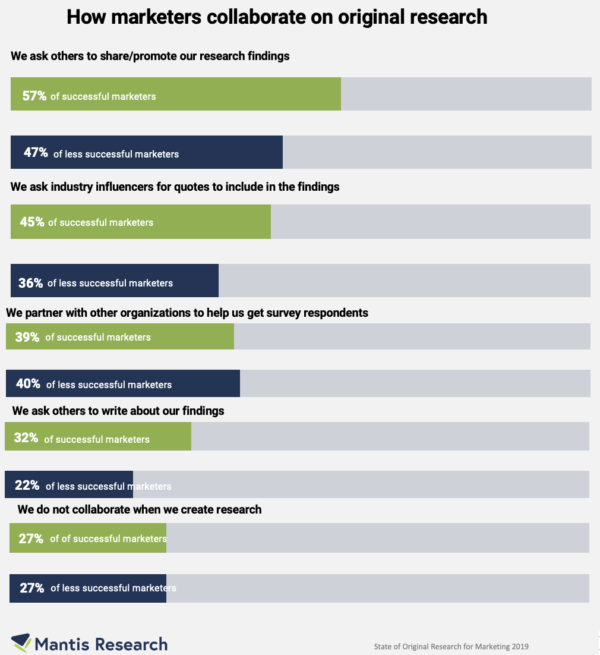 Are you a marketer who publishes your survey-based research – or are you considering it? You likely know how much time and effort go into creating a survey, getting respondents, analyzing the data, writing the findings, and promoting the outcomes to relevant audiences.
Are you a marketer who publishes your survey-based research – or are you considering it? You likely know how much time and effort go into creating a survey, getting respondents, analyzing the data, writing the findings, and promoting the outcomes to relevant audiences.
Knowing what – and how – to prioritize the many steps in a successful research project can make the process a lot less intimidating and easier to manage.
I recently dug into this topic for a study my firm conducted with our friends at BuzzSumo. We surveyed nearly 650 marketers. While the majority consider original research to be effective, some marketers have more success than others.

While the study revealed many valuable data points, let’s explore the category most helpful to you – what the most successful marketers do differently – and how you can use their experiences to benefit your efforts.
61% of marketers doing #originalresearch say it meets most or all expectations. @MantisResearch @BuzzSumo Click To Tweet(NOTE: In this study, the 61% of respondents who reported that original research exceeded or met all/the majority of their expectations are considered “successful.” Those who report that some or none of their expectations were met are labeled “less successful.”)
HANDPICKED RELATED CONTENT:
1. Measure meaningful metrics
We asked respondents to identify the marketing-focused benefits achieved with original research. As you can see from the chart below, successful marketers are more likely to report improved results across all of their marketing goals (with social shares as the only outlier).
While social shares are important for some businesses (and they are easy to measure), my recommendation is to prioritize another metric such as media mentions, backlinks, leads, or subscribers – they likely have more of an impact on your program.
58% of successful marketers see sales leads as a benefit of #originalresearch. @MantisResearch @BuzzSumo Click To TweetHow to improve your focus
While many marketers want their research to do a lot of things, get specific on your key goal(s). Look at your research from that narrow angle.
For instance, if your goal is to drive increased media mentions about your business, prioritize newsworthy stories from the outset of your research planning. For example, one way to attract media coverage is to bust a myth. Think about what questions to ask that may produce surprising results.
However, if your goal is to get backlinks, you may want to use Andy Crestodina’s “find the stat” approach. What does your industry believe to be true, but no one has the data to prove? Become that source and increase your chances of getting backlinks.
For additional insight on how to approach your research project strategically based on your marketing goals, this article is a good place to start.
HANDPICKED RELATED CONTENT:
2. Write story-worthy survey questions
Another thing that separates successful marketers from their less-successful peers is their team’s ability to write survey questions that lend themselves to creating interesting stories, which would help achieve research goals.
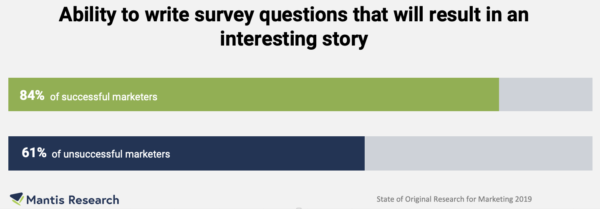
While writing survey questions may seem simple, I speak to many marketers who say they crafted a survey only to find “meh” results when it was time to present them in a compelling, story-driven way.
How to craft insightful questions
Here are two suggestions:
- Ask yourself, “How do you want your audience to think differently as a result of reading your survey?” Thinking about the story you want to tell from a high-level perspective can help narrow the big insights to gather.
- Once your survey question list is nearly final, create an outline of the resulting report. What data might be interesting, and which seems extraneous? What dream headlines could you craft around your results? If you scan the potential data to be collected and nothing strikes you as unique or worthy of your audience’s attention, rework your questions until they tell a more interesting or insightful story.
3. Use survey technology to inject rigor into your data
This next difference gets a bit technical, but it’s worth it. Successful marketers are more likely to use two features – survey logic and respondent disqualification – in their survey technology (e.g., SurveyMonkey, SurveyGizmo).
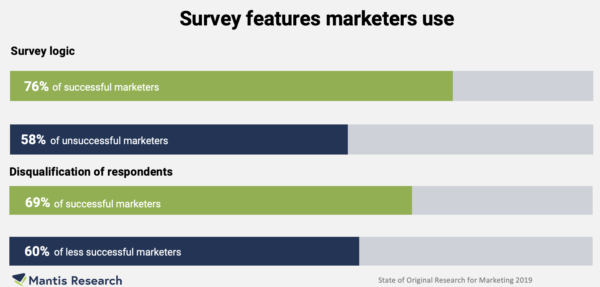
Survey logic allows marketers to customize their survey questions based on how the participants respond to previous questions.
For instance, let’s say you want to examine how managers’ opinions might differ from those who don’t manage others. By using the survey logic functionality included in many survey tools, you can ask which respondents manage others, then follow up with “manager only” questions to better understand their experiences.
Using this logic is important because it avoids asking questions that respondents don’t have the knowledge or context to answer – giving you more accurate, relevant responses rather than best guesses.
The disqualify-respondents feature means you ask one or more questions to verify if the right target person is taking your survey.
Using survey logic & disqualification features make survey results more credible, says @MicheleLinn. #researchtips Click To TweetFor instance, according to CMI’s B2B Content Marketing: Benchmarks, Budgets and Trends 2019 methodology, only those who have a content marketing function and who have been working in content marketing for a year were able to complete the survey. This level of specificity makes the results more credible.
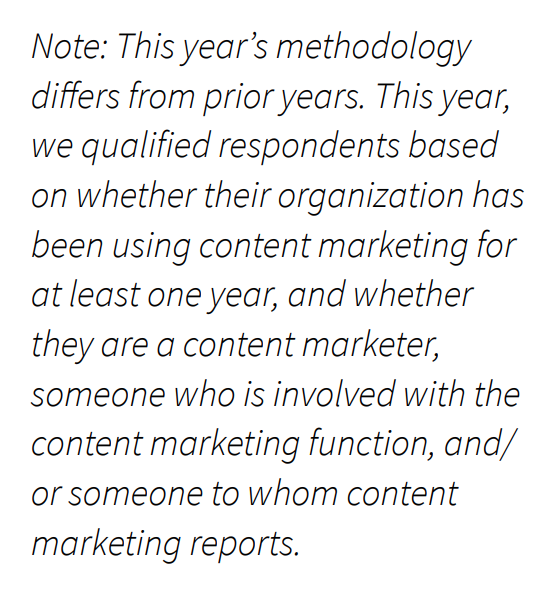
How to use survey tech to create “deep-dive” insights
Not all survey tools – and plans – are created equal. If you’re willing to pay for a plan, look for tools that allow you to use survey logic and/or disqualification. By incorporating these features – and disclosing them in your results explanation – you will improve the credibility of your survey results and make them more valuable.
4. Use social media and partnerships to find respondents
Getting survey respondents is often one of the top concerns that marketers have when starting a survey-based research project, and it’s no surprise that those who are having success with research are less likely to struggle in this respect.
Getting survey respondents is one of the top concerns for marketers, says @MicheleLinn. #originalresearch Click To TweetEven though most marketers send invitations to people on their mailing lists, successful marketers are more likely to use social media, partner with another organization, or pay for third-party panels to get respondents.
If you pay a third party to provide a panel, you can be as specific or broad in the type of people you want to take the survey. Costs increase as you require more specific criteria. As a general rule, consumer-based audiences are a more cost-effective group to survey than business professionals.
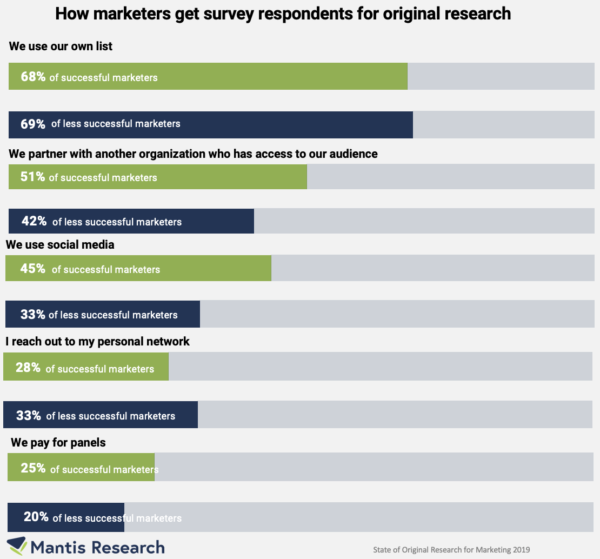
How to increase survey participation
If you are like most marketers I talk to who don’t have a large, engaged list that checks all of the criteria boxes, consider partnering with one or more organizations. The best partners are those who have a large audience of those you want to survey and would benefit from having the data. While there are myriad ways to incentivize partners, some ideas include:
- Publishing logo on the report cover
- Mentioning in report overview
- Co-branding on all the charts
- Offering exclusive access to the data
- Mentioning the partnership in your blog posts
- Including a sponsor ad in the PDF of the report
Here’s how Buffer recognized its survey partners in its annual State of Remote Work:
5. Collaborate with others
Marketers who are successful with research are also more likely to collaborate. Among the results:
- 57% ask others to help promote their findings.
- 45% ask industry experts for quotes to include in reports.
- 32% ask others to write about their findings.
These findings come as no surprise, but they serve as a good reminder about the extra steps you can take to improve the reach of your research content.
Click to enlarge
How to involve relevant influencers
This post from Amanda Subler is an oldie but goodie – and one I still share. In it, she outlines her process for sharing research with influencers.
Not sure how to even identify influencers? Andy Crestodina has you covered with his step-by-step process. As Andy explains:
The more you share w/ your target audience, the more authority you’re building, says @crestodina. Click To TweetDon’t just publish one thing. The more you share with your target audience, the more authority you’re building, and the easier it will be to get better coverage in the future. Can the first report you release become a yearly report? Did the people’s comments/responses on the first report spark ideas for future ones? Find more ways you can provide value.
HANDPICKED RELATED CONTENT:
6. Include demographic details in your methodology
Another attribute of marketers who successfully leverage research is that they are more likely to include demographic details of the respondents in their report’s methodology section.
In consumer-based studies, common demographic details include location, gender, and age, whereas business-focused studies are more likely to collect information such as the size of the company, years of experience, and location.
Including demographics is simply a good practice, but it is also a must-have for your research to be perceived as credible.
Including demographics is a best practice, but it’s also a must-have for your #research to be credible. @MicheleLinn Click To Tweet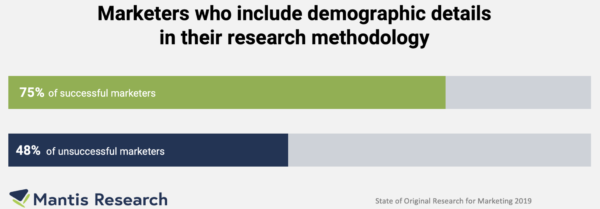
How to use demographics to expand your story options
You also can use this information to analyze your data in new ways. For instance, you can compare the results between men and women or look at how attitudes differ among generations. Or, if you are surveying business professionals, you can compare results based on years of experience or size of company.
7. Produce additional content from your research
Marketers having success with research are more likely to create additional content from their findings. This makes logical sense: Those who continually publish insights from their data in different formats are more likely to get their research in front of more eyes.
Marketers who continually publish insights in different formats get more eyes on their #research. @MicheleLinn Click To Tweet
The most common types all marketers create with their research are blog posts, infographics, and social sharing assets. But the successful marketers are more likely to create industry presentations and articles on other websites. However, as explained below, always make sure the type of content is tied to your goal.
How to create content that extends the value of your research
While the opportunities to create content from your research data can feel endless, prioritize them based on your goals. The chart below reflects general research goals to types of content:
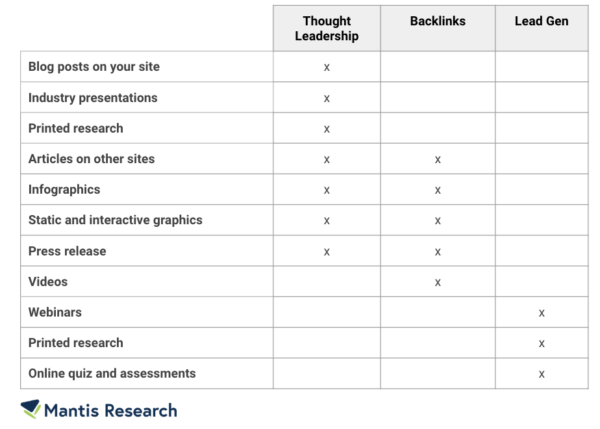
HANDPICKED RELATED CONTENT:
Recap of successful original research
The best research combines three things:
- Compelling story
- Credible data
- Smart promotion
To accomplish that – and approach your next research project with more confidence – consider these seven lessons:
- Focus on a goal that matters.
- Draft survey questions that will result in a strong story.
- Use survey logic to disqualify the people who aren’t in the targeted survey audience.
- Use one or more partners to distribute your survey.
- Publish a methodology that includes demographic details.
- Ask others to share your research or be quoted.
- Create more content from your research.
Delve deeper into how to do original research the right way for your brand. Attend Content Marketing World September 3-6. Use code CMIBLOG100 to save $100. Register today. And make sure to attend Michele Linn’s session on Sept. 5.
Please note: All tools included in our blog posts are suggested by authors, not the CMI editorial team. No one post can provide all relevant tools in the space. Feel free to include additional tools in the comments (from your company or ones that you have used).
Cover image by Joseph Kalinowski/Content Marketing Institute


